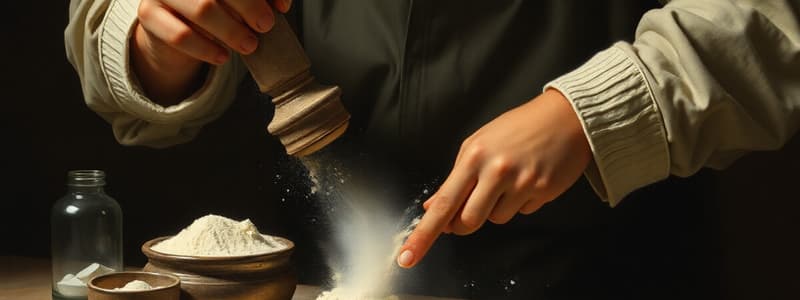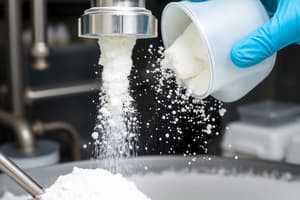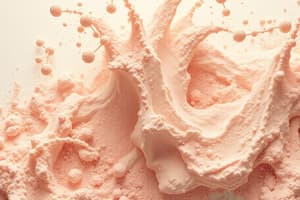Podcast
Questions and Answers
What is the primary role of a fluidised bed mixer in powder mixing?
What is the primary role of a fluidised bed mixer in powder mixing?
- To reduce energy consumption
- To subject powder to a flowing gas stream (correct)
- To eliminate particle segregation
- To increase the weight of the particles
What is the optimal loading ratio range for fluidised bed mixers?
What is the optimal loading ratio range for fluidised bed mixers?
- 35-45%
- 20-30% (correct)
- 50-70%
- 25-35%
Which factor is NOT a consideration for selecting a mixer based on safety?
Which factor is NOT a consideration for selecting a mixer based on safety?
- Particle color (correct)
- Energy consumption
- Dust emission
- Mixer speed
What might lead to segregation during powder mixing?
What might lead to segregation during powder mixing?
Which of the following is a concern related to the energy consumption of a mixer?
Which of the following is a concern related to the energy consumption of a mixer?
What is the main aim of powder mixing?
What is the main aim of powder mixing?
Which of the following accurately describes dry mixing?
Which of the following accurately describes dry mixing?
What factor does mixing affect in solid dosage forms?
What factor does mixing affect in solid dosage forms?
What is the purpose of pre-mixing in powder mixing?
What is the purpose of pre-mixing in powder mixing?
What type of mixers are tumbler mixers suitable for?
What type of mixers are tumbler mixers suitable for?
What is a primary advantage of using a Y-cone or cylinder mixer for powder mixing?
What is a primary advantage of using a Y-cone or cylinder mixer for powder mixing?
Which disadvantage is associated with convective mixers?
Which disadvantage is associated with convective mixers?
What is a major characteristic of impaction mixers?
What is a major characteristic of impaction mixers?
How does the internal impeller in a convective mixer assist in the mixing process?
How does the internal impeller in a convective mixer assist in the mixing process?
What is a disadvantage of using an impaction mixer?
What is a disadvantage of using an impaction mixer?
Which type of mixer is noted for its less fine particle segregation?
Which type of mixer is noted for its less fine particle segregation?
Which type of tower mixer is rarely used for dry powder mixing?
Which type of tower mixer is rarely used for dry powder mixing?
What component can reduce particle segregation in Y-cone and cylinder mixers?
What component can reduce particle segregation in Y-cone and cylinder mixers?
What is the main difference between diffusion and convection in mixing mechanisms?
What is the main difference between diffusion and convection in mixing mechanisms?
Which mixer type is primarily used for very cohesive, agglomerated powders?
Which mixer type is primarily used for very cohesive, agglomerated powders?
In which situation would you likely employ the process of granulation?
In which situation would you likely employ the process of granulation?
What does a 'perfect mix' imply regarding particle arrangement?
What does a 'perfect mix' imply regarding particle arrangement?
Which factor does NOT affect powder segregation?
Which factor does NOT affect powder segregation?
What should be done to mitigate problems caused by particle size during mixing?
What should be done to mitigate problems caused by particle size during mixing?
What does a probabilistic chance of 1 in 4 mean when selecting two particles from a mixture?
What does a probabilistic chance of 1 in 4 mean when selecting two particles from a mixture?
What is the purpose of testing for drug content uniformity?
What is the purpose of testing for drug content uniformity?
Why is it important to control the crystallization process regarding particle shape?
Why is it important to control the crystallization process regarding particle shape?
Flashcards
Powder Mixing
Powder Mixing
The process where particles of different powders are mixed as evenly as possible to ensure homogeneity in the final powder blend.
Dry Mixing
Dry Mixing
Powder mixing where no liquids are added. The powders are combined in their dry form.
Wet Mixing
Wet Mixing
Powder mixing where a liquid binder is added to the powder mixture, creating granules.
Pre-mixing
Pre-mixing
Signup and view all the flashcards
Post-mixing
Post-mixing
Signup and view all the flashcards
Fluidized Bed Mixing
Fluidized Bed Mixing
Signup and view all the flashcards
Optimal Loading Ratio
Optimal Loading Ratio
Signup and view all the flashcards
Powder Segregation
Powder Segregation
Signup and view all the flashcards
Overmixing (Powder)
Overmixing (Powder)
Signup and view all the flashcards
Economical & Safety Factors in Powder Mixing
Economical & Safety Factors in Powder Mixing
Signup and view all the flashcards
Y-cone Mixer
Y-cone Mixer
Signup and view all the flashcards
Convective Mixer
Convective Mixer
Signup and view all the flashcards
Impaction Mixer
Impaction Mixer
Signup and view all the flashcards
High Shear Mixer
High Shear Mixer
Signup and view all the flashcards
Turbula Mixer
Turbula Mixer
Signup and view all the flashcards
Double Cone Mixer
Double Cone Mixer
Signup and view all the flashcards
Planetary Mixer
Planetary Mixer
Signup and view all the flashcards
Nautamixer
Nautamixer
Signup and view all the flashcards
Diffusion (Micromixing)
Diffusion (Micromixing)
Signup and view all the flashcards
Convection (Macromixing)
Convection (Macromixing)
Signup and view all the flashcards
Shear
Shear
Signup and view all the flashcards
Simple Tumbling Mixer
Simple Tumbling Mixer
Signup and view all the flashcards
Low Shear Blade/Paddle Mixer
Low Shear Blade/Paddle Mixer
Signup and view all the flashcards
Ordered Mixture
Ordered Mixture
Signup and view all the flashcards
Random Mixture
Random Mixture
Signup and view all the flashcards
Segregation
Segregation
Signup and view all the flashcards
Study Notes
MPharm Programme: Powder Mixing
- Powder mixing is the treatment of two or more powder components so each particle of one component is in contact with one of each additional component.
- The aim is to achieve a homogenous distribution of components in the bulk powder.
- Components of a powder mix include different powders (drugs and excipients), different particle size fractions of the same powder.
- Powder mixing is crucial for granulation, tablet making, direct compression, capsule/sachet filling, and vial filling for injections.
- Different properties of drugs and excipients affect mixing, including homogeneity of drug distribution in dosage forms, mechanical properties (e.g. of tablets), and drug bioavailability.
Mixing Terminology
- Dry mixing: powders mixed without liquid additions
- Wet mixing: powder mixed with a liquid binder (granulation)
- Pre-mixing: used for mixtures with less than 5% w/w drug, followed by further deagglomeration (e.g., sieving).
- Post-mixing: adding an external phase (e.g., lubricant or glidant) with short mixing times (3-5 minutes).
Mixer Types
- Tumbler mixers: rotating vessels, prone to particle segregation, but internal impellers/prongs can reduce this. Useful for adding lubricants and glidants to granules.
- Cube, cone and V mixers: (illustrated)
- Turbula mixer: (illustrated)
- Double cone mixer: (illustrated)
- Convective mixers: fixed vessel with an internal impeller, less prone to fine particle segregation but have dead spaces, adhesion to blades, and shear forces that can shatter particles.
- Planetary mixing: (illustrated)
- Nautamixer: (illustrated)
- Impaction & high shear mixers: high-energy input, blades rotating at high speeds (2000-3000 rpm) in static vessels. Break up aggregates, often used after tumbling mixing.
- Impaction mixer: (illustrated)
- Fluidized bed mixers: powders subjected to a flowing gas stream; weight of particles is counterbalanced by buoyancy, increasing particle mobility and efficiency.
Choice of Mixer
- Physical Considerations: More space is needed, optimal loading ratio needed with respect to vessel volume (tumbling mixers – 25-35%, convective mixers – 50-80%, fluidised bed mixers – 20-30%). Need to consider particle distribution, limit particle attrition & overmixing, and temperature change.
- Economic and Safety Considerations: Energy consumption, mixing time, continuous vs. batch mixing, time to fill, empty, and clean, dust emission, explosion hazard (electrostatic charging), surfaces/mixer speed, relative humidity.
Mixing Mechanisms
- Expansion: Allows movement of particles
- Agitation: Ensures sufficient period for mix.
- Avoidance of segregation
- Maintenance of adequate mix
- Particle movement: Diffusion (random), convection (transfer of groups of particles), shear (sliding particle layers).
- Mixer design determines which mechanism is dominant (e.g., simple tumbling mixers - free flow, high shear mixers - cohesive powders).
Interactive Powder Mixtures ('Ordered Mixtures')
- Cohesive fine powders (<20 µm), coarse powders (coater/carrier units).
- Interparticulate forces, improves homogeneity.
- Ordered units have a definable size range.
Stable Powder Mixtures ('Ordered Mixtures')
- Vibrating on a sieve (seeding).
- Results: Segregation: ordered unit segregation (size difference), displacement segregation (3rd component), saturation segregation (limited surface sites).
Free-flowing Mixtures ('Random Mixtures')
- No interparticulate forces, particles move freely.
- Random distribution (governed by stochastic/statistical process).
- Complete random mixture only if all components are identical in size, shape, and density.
- Median size > 20 µm, used for direct compression.
Perfect/Random Mixtures
- Each particle in a 'perfect mix' lies adjacent to another particle from a different component.
- Random mix: maximum disorder - no way to predict particle type from neighbour.
Factors Affecting Segregation
- Particle size, density, shape
- Electrostatic charging, powder handling.
Particle Size Effects
- Large particles give poor distribution
- Particle size reduction gives good distribution.
- Particle agglomeration gives poor distribution.
Testing Drug Content Uniformity in Powder Mix
- Random samples, analysis of drug content.
- Inspection: standard deviation, coefficient of variation
- Comparing with pharmacopoeial tests.
- Effect of mixing variables.
Studying That Suits You
Use AI to generate personalized quizzes and flashcards to suit your learning preferences.





